Detection Stability Improvement of Near-Infrared Laser Telemetry for Methane Emission from Oil/Gas Station Using a Catadioptric Optical Receiver
Abstract
:1. Introduction
2. Methods
2.1. Optical Model of Convergence Point Offsets for Fresnel Lens
2.2. Optical Model of Segmentation Cell of a Parabolic Reflector for COR
3. Results and Discussion
3.1. Structural Parameters for Optimization Analysis of COR
3.2. Performance Analysis of Methane Laser Telemetry Coupled with the COR System
4. Conclusions
- (1)
- Compared with FOR, the receiving angle of COR increased 3.8 times. Compared with POR, their optical efficiency decreases rapidly when the incident angle was greater than 5°, but the optical efficiency of COR was still significantly higher than that of POR.
- (2)
- The RMSE and IS of the COR system were 0.00173 V and 84.79%, respectively. For comparison, these two evaluating indicators of the FOR system were 0.00288 V and 76.23%. The developed catadioptric optical receiver provided superior stability for laser telemetry of methane.
Author Contributions
Funding
Data Availability Statement
Conflicts of Interest
Nomenclature
| d | Deviation of the echo light ray convergence point for COR, cm | Greek letters | |
| f | Focal length of the Fresnel lens, mm | α | Vertex angle of serrate prism, ° |
| h | Vertical distance between the exiting point and the optical axis, cm | tan β | Reflecting surface inclination, ° |
| L | Horizontal distance between the exiting point and the incident plane, cm | δ | Deviation of the echo light ray convergence point for the Fresnel lens, cm |
| n | Refractive index of the Fresnel lens, - | μ1 | Incident angle on the incident plane of the Fresnel lens, ° |
| N | Total number of data samples, - | μ1′ | Refraction angle on the incident plane, ° |
| R1 | Incident aperture of the annular condenser cell, cm | μ2 | Incident angle on the exiting plane of the Fresnel lens, ° |
| R2 | Exit aperture of the annular condenser cell, cm | μ2′ | Refraction angle on the exiting plane, ° |
| u | Incident angle of echo light ray, ° | ||
| u′ | Exiting angle of echo light ray, ° | ||
| Xi | Measured signal amplitude data, - | ||
| X0 | Real signal amplitude, - | ||
| Xmax | Maximum measurement data, - | ||
| Xmin | Minimum measurement data, - | ||
| Xmean | Average measurement data, - | ||
References
- Allen, D.T.; Cardoso-Saldaña, F.J.; Kimura, Y.; Chen, Q.; Xiang, Z.; Zimmerle, D.; Bell, C.; Lute, C.; Duggan, J.; Harrison, M. A Methane Emission Estimation Tool (MEET) for predictions of emissions from upstream oil and gas well sites with fine scale temporal and spatial resolution: Model structure and applications. Sci. Total Environ. 2022, 829, 154277. [Google Scholar] [CrossRef] [PubMed]
- Floerchinger, C.; McKain, K.; Bonin, T.; Peischl, J.; Biraud, S.C.; Miller, C.; Ryerson, T.B.; Wofsy, S.C.; Sweeney, C. Methane emissions from oil and gas production on the North Slope of Alaska. Atmos. Environ. 2019, 218, 116985. [Google Scholar] [CrossRef]
- Konieczna, A.; Roman, K.; Borek, K.; Grzegorzewska, E. GHG and NH3 Emissions vs. Energy Efficiency of Maize ProductionTechnology: Evidence from PolishFarms; a Further Study. Energies 2021, 14, 5574. [Google Scholar] [CrossRef]
- Sun, S.; Ma, L.; Li, Z. A Source-Level Estimation and Uncertainty Analysis of Methane Emission in China’s Oil and Natural Gas Sector. Energies 2022, 15, 3684. [Google Scholar] [CrossRef]
- Heydarzadeh, Z.; Kinnon, M.M.; Thai, C.; Reed, J.; Brouwer, J. Marginal methane emission estimation from the natural gas system. Appl. Energy 2020, 277, 11557. [Google Scholar] [CrossRef]
- Brandt, A.R.; Heath, G.; Kort, E.; O’sullivan, F.; Petron, G.; Jordaan, S.; Tans, P.; Wilcox, J.; Gopstein, A.; Arent, D.; et al. Methane leaks from north american natural gas systems. Science 2014, 343, 733–735. [Google Scholar] [CrossRef]
- Wang, J.; Ji, J.; Ravikumar, A.P.; Savarese, S.; Brandt, A.R. VideoGasNet: Deep learning for natural gas methane leak classification using an infrared camera. Energy 2022, 238, 121516. [Google Scholar] [CrossRef]
- MacKay, K.; Lavoie, M.; Bourlon, E.; Atherton, E.; O’Connell, E.; Baillie, J.; Fougere, C.; Risk, D. Methane emissions from upstream oil and gas production in Canada are underestimated. Sci. Rep. 2021, 11, 8041. [Google Scholar] [CrossRef]
- Liu, C.; Wang, Y.; Li, Y.; Xu, M. Experimental study on new leak location methods for natural gas pipelines based on dynamic pressure waves. J. Nat. Gas Sci. Eng. 2018, 54, 83–91. [Google Scholar] [CrossRef]
- Bakkaloglu, S.; Lowry, D.; Fisher, R.E.; France, J.L.; Brunner, D.; Chen, H.; Nisbet, E.G. Quantification of methane emissions from UK biogas plants. Waste Manag. 2021, 124, 82–93. [Google Scholar] [CrossRef]
- Kordella, S.; Ciotoli, G.; Dimas, X.; Papatheodorou, G.; Etiope, G. Increased methane emission from natural gas seepage at Katakolo Harbour (Western Greece). Appl. Geochem. 2020, 116, 104578. [Google Scholar] [CrossRef]
- Schimmelmann, A.; Ensminger, S.A.; Drobniak, A.; Mastalerz, M.; Etiope, G.; Jacobi, R.D.; Frankenberg, C. Natural geological seepage of hydrocarbon gas in the Appalachian Basin and Midwest USA in relation to shale tectonic fracturing and past industrial hydrocarbon production. Sci. Total Environ. 2018, 644, 982–993. [Google Scholar] [CrossRef] [PubMed]
- Hollenbeck, D.; Zulevic, D.; Chen, Y. Advanced Leak Detection and Quantification of Methane Emissions Using sUAS. Drones 2021, 5, 117. [Google Scholar] [CrossRef]
- Zhang, E.J.; Teng, C.C.; van Kessel, T.G.; Klein, L.; Muralidhar, R.; Wysocki, G.; Green, W.M.J. Field Deployment of a Portable Optical Spectrometer for Methane Fugitive Emissions Monitoring on Oil and Gas Well Pads. Sensors 2019, 19, 2707. [Google Scholar] [CrossRef]
- Ro, K.S.; Johnson, M.H.; Varma, R.M.; Hashmonay, R.A.; Hunt, P. Measurement of greenhouse gas emissions from agricultural sites using open-path optical remote sensing method. J. Environ. Sci. Health A 2009, 44, 1011–1018. [Google Scholar] [CrossRef] [PubMed]
- He, H.; Gao, S.; Hu, J.; Zhang, T.; Wu, T.; Qiu, Z.; Zhang, C.; Sun, Y.; He, S. In-situ testing of methane emissions from landfills using laser absorption spectroscopy. Appl. Sci. 2021, 11, 2117. [Google Scholar] [CrossRef]
- Xia, J.; Zhu, F.; Zhang, S.; Kolomenskii, A.; Dong, J.; Okada, K.; Strohaber, J.; Schuessler, H.A. Probing greenhouse gases in turbulent atmosphere by long-range open-path wavelength modulation spectroscopy. Opt. Laser Eng. 2019, 117, 21–28. [Google Scholar] [CrossRef]
- Zhu, H.; Letzel, M.O.; Reiser, M.; Kranert, M.; Bächlin, W.; Flassak, T. A new approach to estimation of methane emission rates from landfills. Waste Manag. 2013, 33, 2713–2719. [Google Scholar] [CrossRef]
- Li, J.; Du, Z.; Liu, C. Standoff Chemical Detection Using Laser Absorption Spectroscopy: A Review. Remote Sens. 2020, 12, 2771. [Google Scholar] [CrossRef]
- Lewellen, J.W.; Harris, J.R. Performance estimates for a multicube retroreflector design. Opt. Commun. 2019, 441, 26–32. [Google Scholar] [CrossRef]
- Shen, S.; Li, W.; Wang, M.; Wang, D.; Li, Y.; Li, D. Methane near-infrared laser remote detection under non-cooperative target condition based on harmonic waveform recognition. Infrared Phys. Technol. 2022, 120, 103977. [Google Scholar] [CrossRef]
- Barrass, S.; Gérard, Y.; Holdsworth, R.J.; Martin, P.A. Near-infrared tunable diode laser spectrometer for the remote sensing of vehicle emissions. Spectrochim. Acta A 2004, 60, 3353–3360. [Google Scholar] [CrossRef] [PubMed]
- Yang, H.; Bu, X.; Cao, Y.; Song, Y. A methane telemetry sensor based on near-infrared laser absorption spectroscopy. Infrared Phys. Technol. 2021, 114, 103670. [Google Scholar] [CrossRef]
- Zhang, Y.; Ding, J.; Zhang, X.; Fang, J.; Zhao, Y. Open-path sensor based on QCL for atmospheric N2O measurement. Results Phys. 2021, 31, 104909. [Google Scholar] [CrossRef]
- Shao, L.; Fang, B.; Zheng, F.; Qiu, X.; He, Q.; Wei, J.; Li, C.; Zhao, W. Simultaneous detection of atmospheric CO and CH4 based on TDLAS using a single 2.3 μm DFB laser. Spectrochim. Acta A 2019, 222, 117118. [Google Scholar] [CrossRef]
- Li, G.; Ma, K.; Jiao, Y.; Jiang, Q.; Zhang, X.; Zhang, Z.; Wu, Y.; Song, D. Performance enhancement of DFBL based near-infrared CH4 telemetry system using a focus tunable lens. Microw. Opt. Technol. Lett. 2021, 63, 1147–1151. [Google Scholar] [CrossRef]
- Xiao, C.; Hu, S. Optimization of the Optical Path of the Methane Telemetry System Based on TDLAS Technology. In Proceedings of the International Conference on Optical Instruments and Technology: Optical Systems and Modern Optoelectronic Instruments, Beijing, China, 2–4 November 2020; p. 114341B. [Google Scholar]
- Xu, N.; Ji, J.; Sun, W.; Huang, W.; Li, J.; Jin, Z. Numerical simulation and experimental validation of a high concentration photovoltaic/thermal module based on point-focus Fresnel lens. Appl. Energy 2016, 168, 269–281. [Google Scholar] [CrossRef]
- Cabral, D. Development and performance comparison of a modified glazed CPC hybrid solar collector coupled with a bifacial PVT receiver. Appl. Energy 2022, 325, 119653. [Google Scholar] [CrossRef]
- Peng, X.; Kong, L. Design and optimization of optical receiving antenna based on compound parabolic concentrator for indoor visible light communication. Opt. Commun. 2020, 464, 125447. [Google Scholar] [CrossRef]
- Wang, D.; Wu, G.; Li, D.; Qi, H.; Lv, Y. Research on Echo Power Detection Based on Laser Radiation Transmission Characteristics of Non-Cooperative Target Surface. In Proceedings of the 16th International Heat Transfer Conference, Beijing, China, 13 August 2018. [Google Scholar]
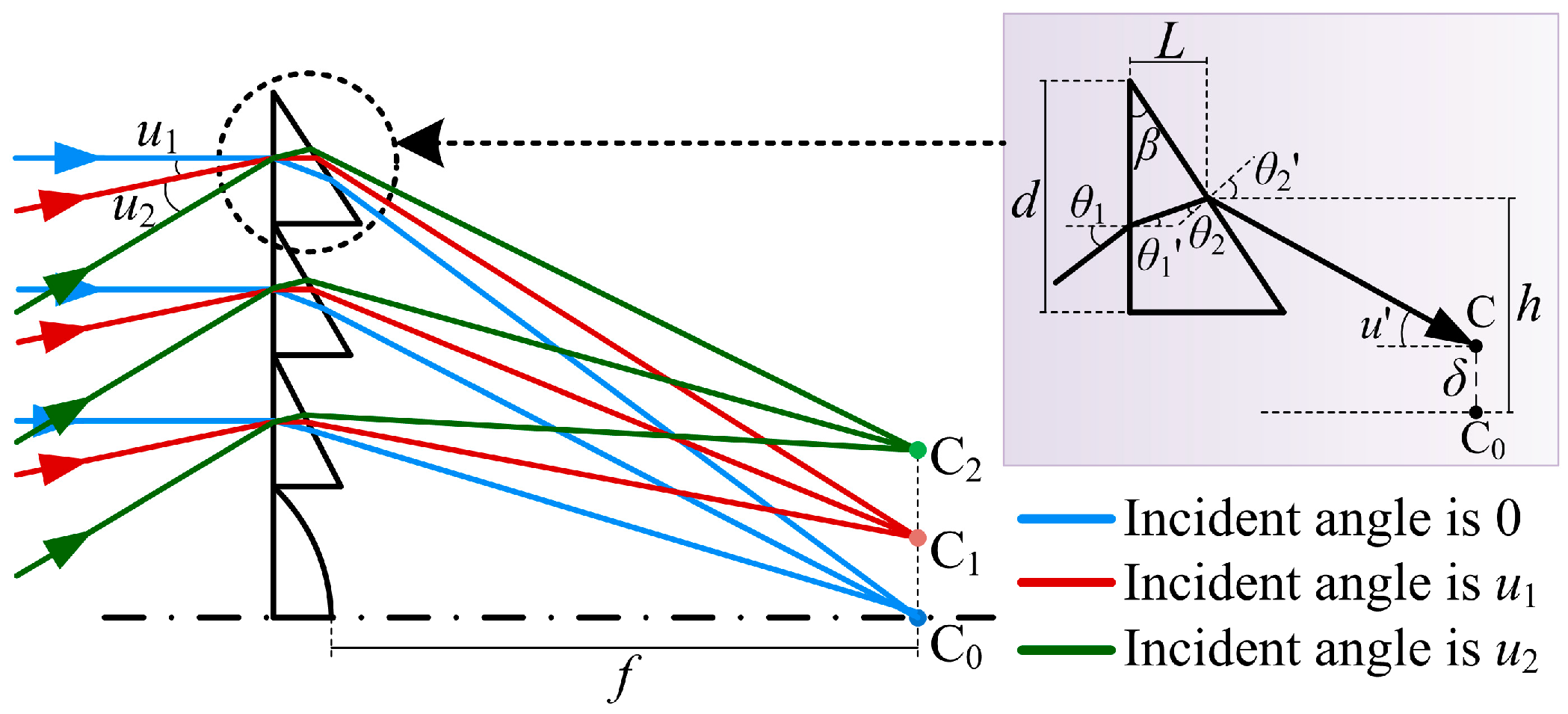

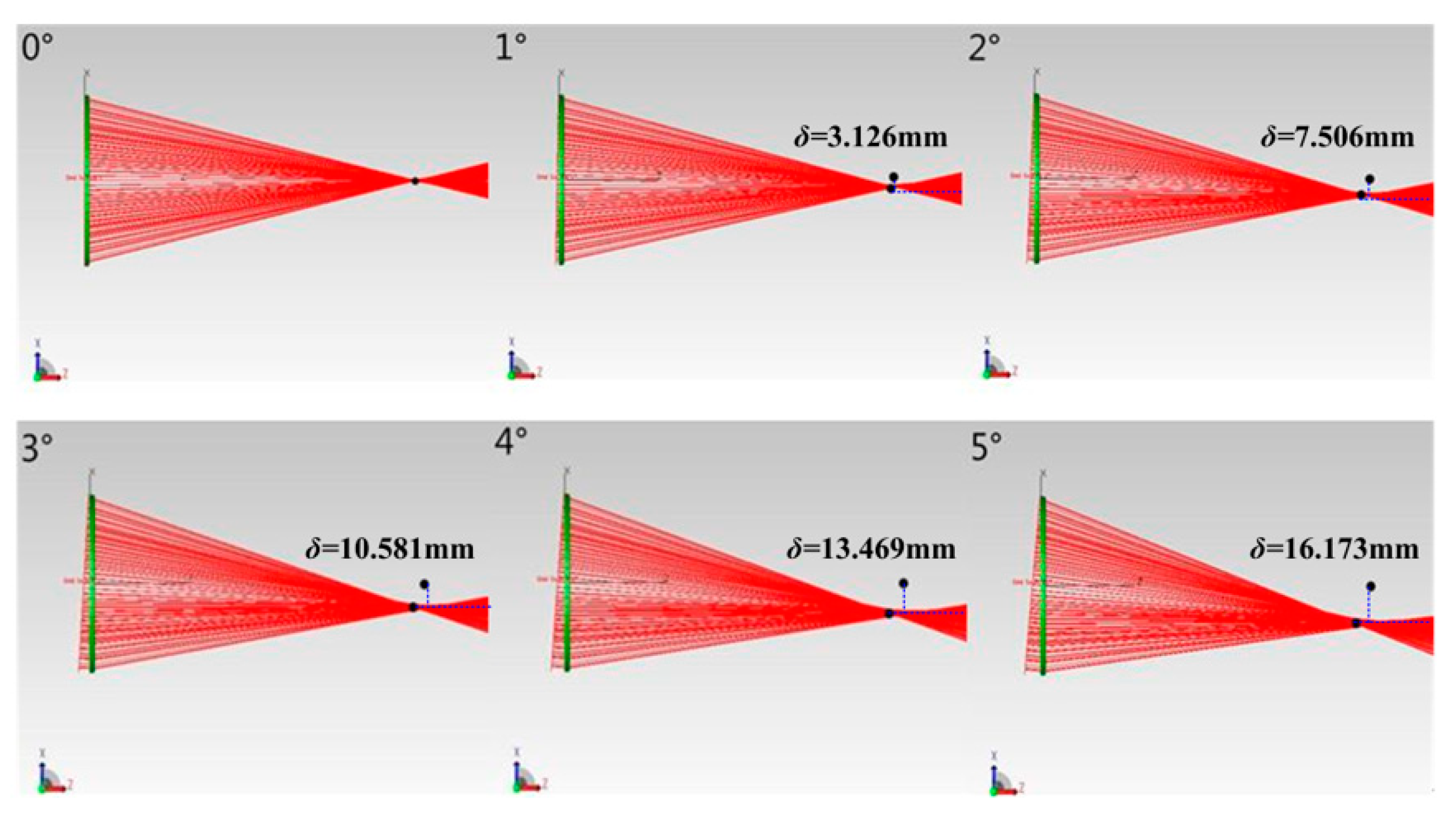
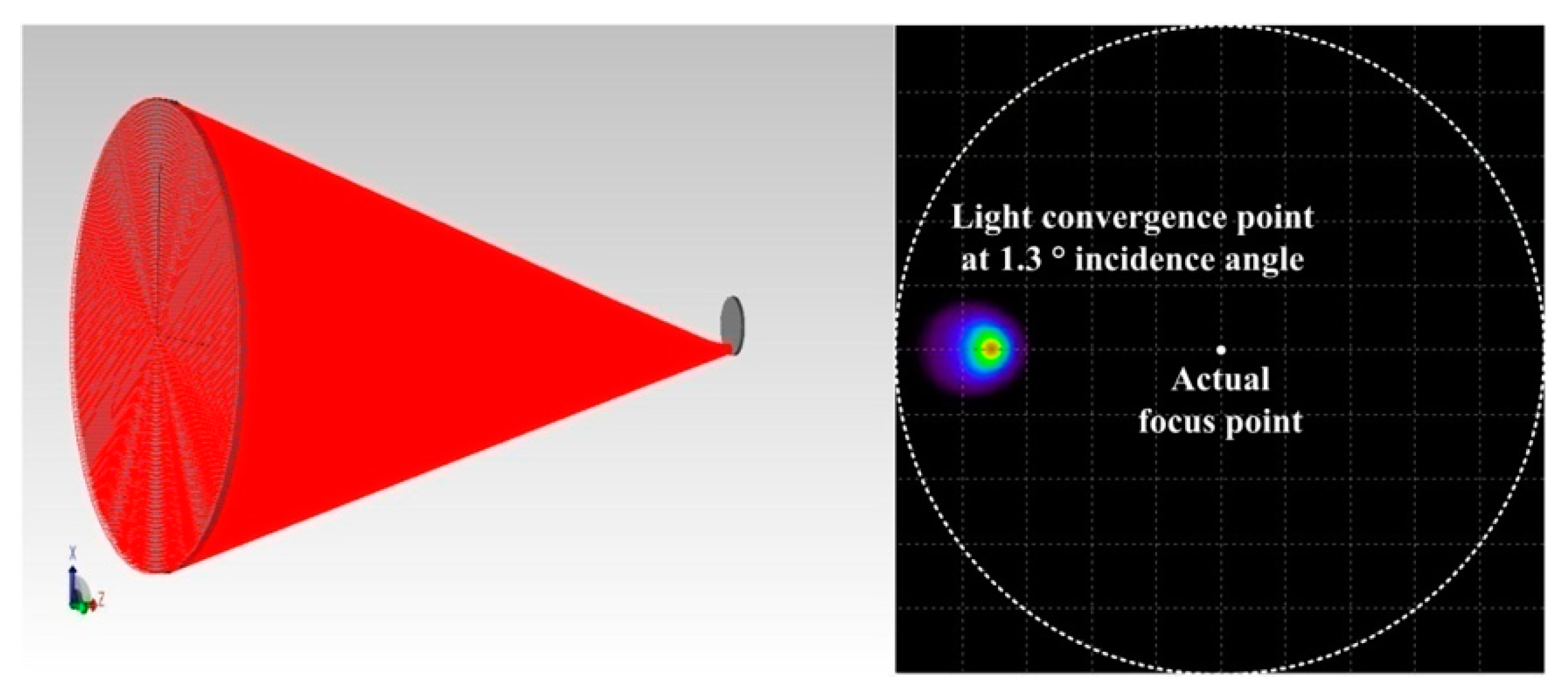

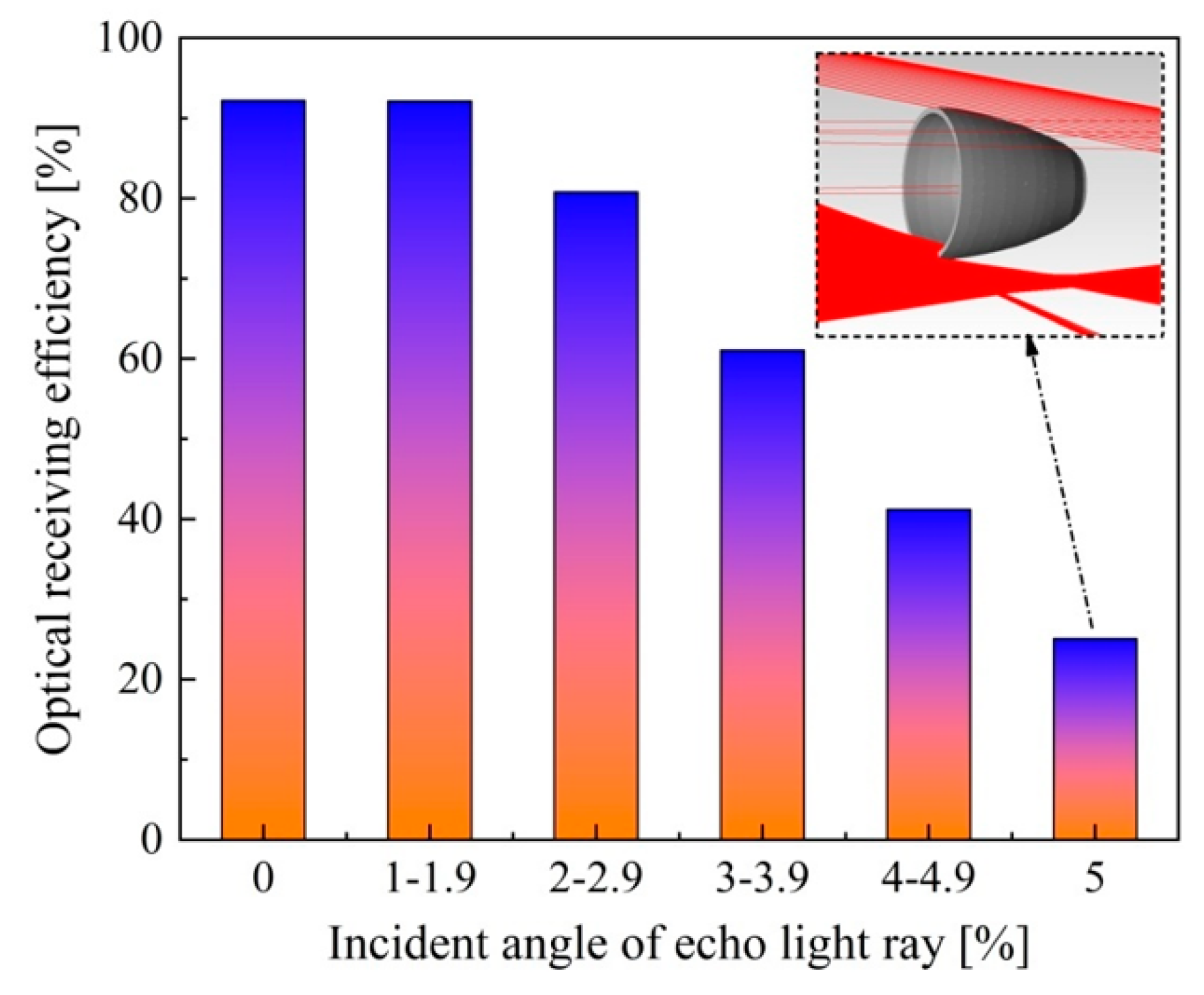
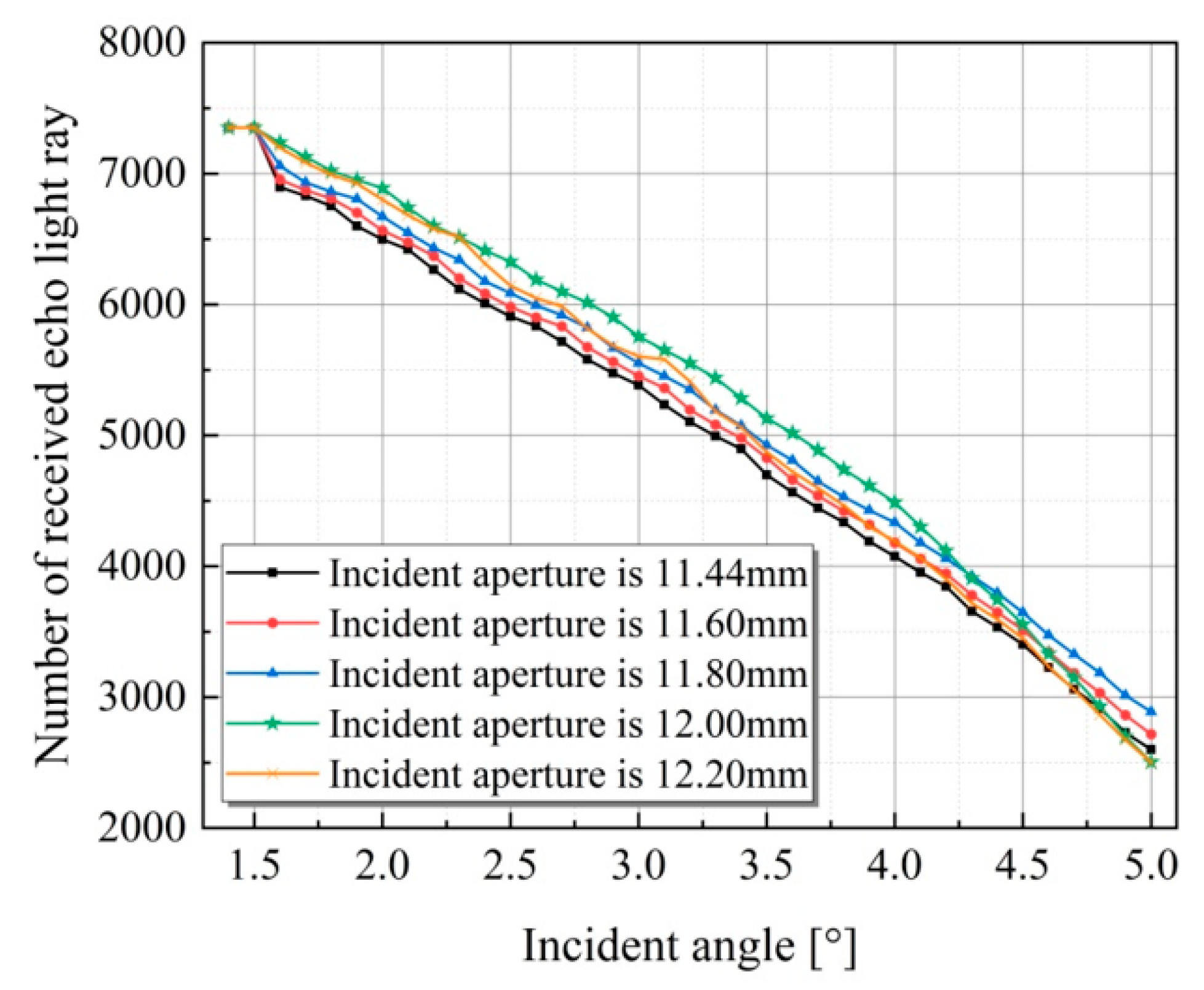
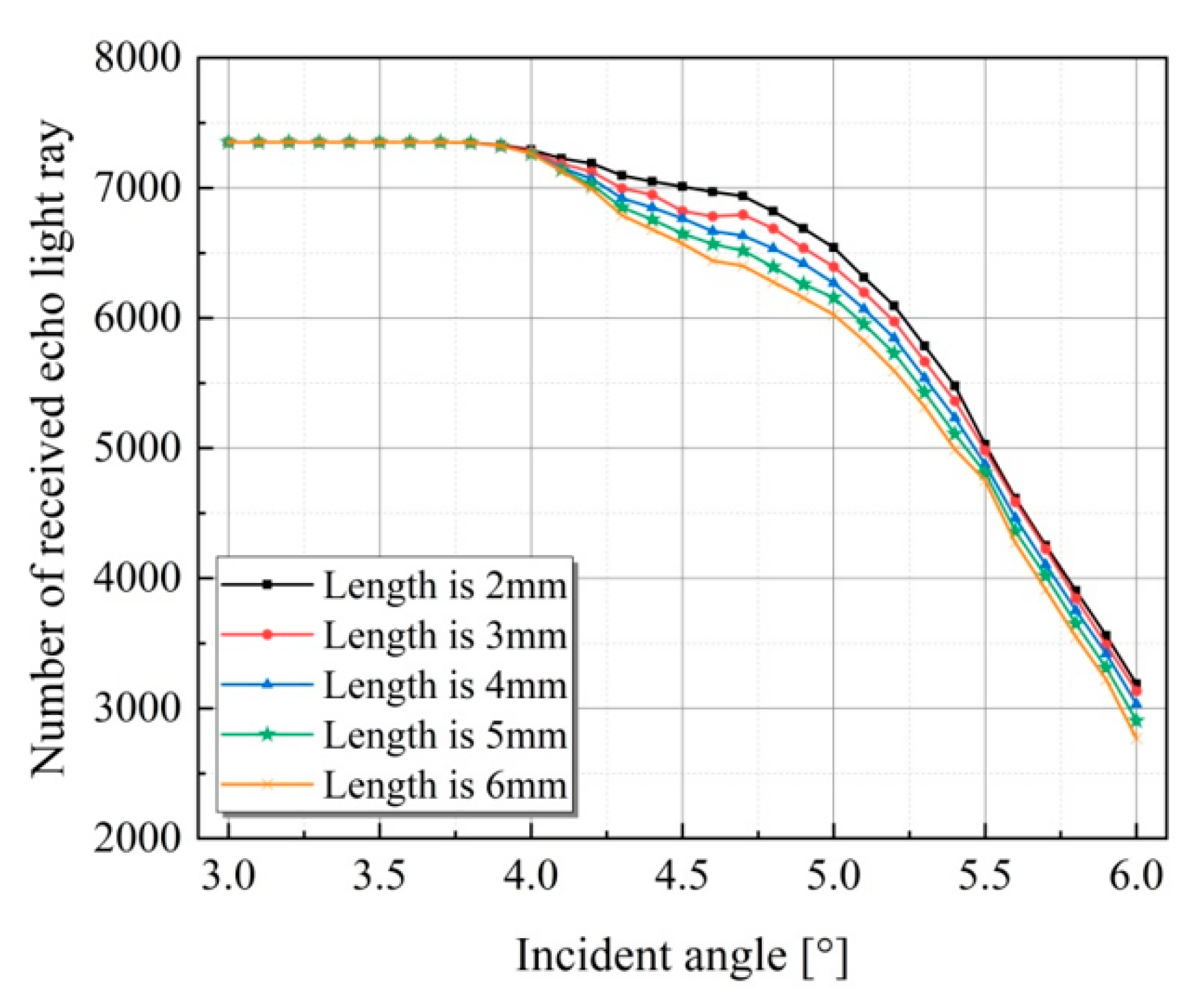


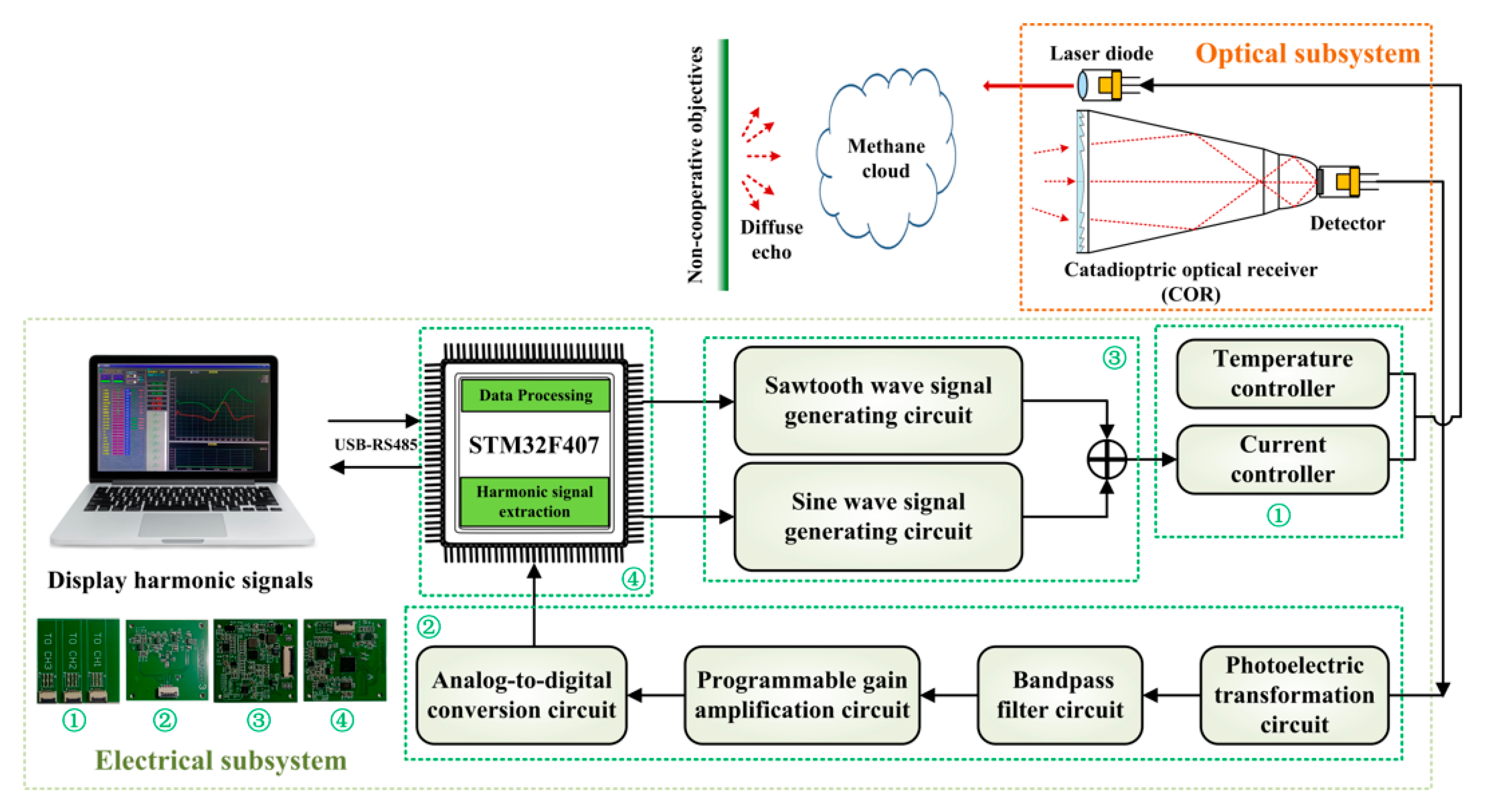
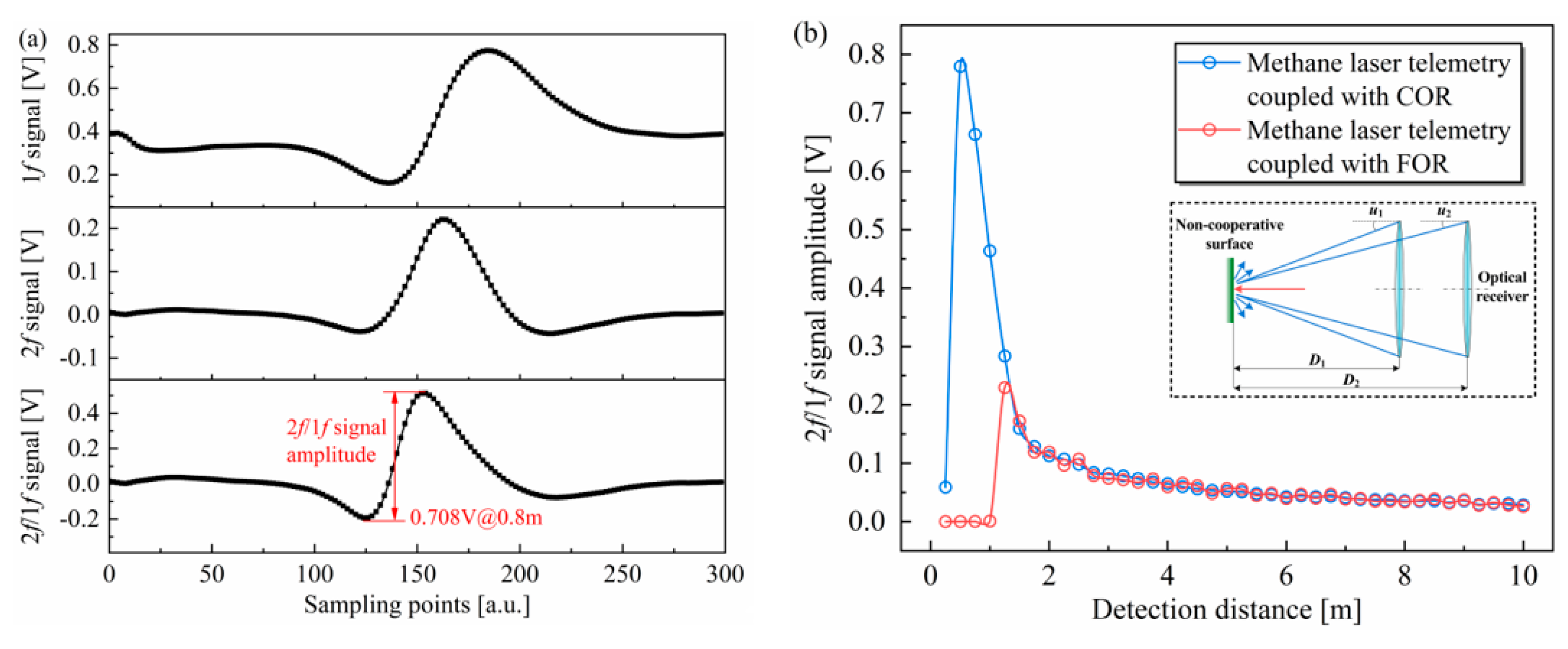

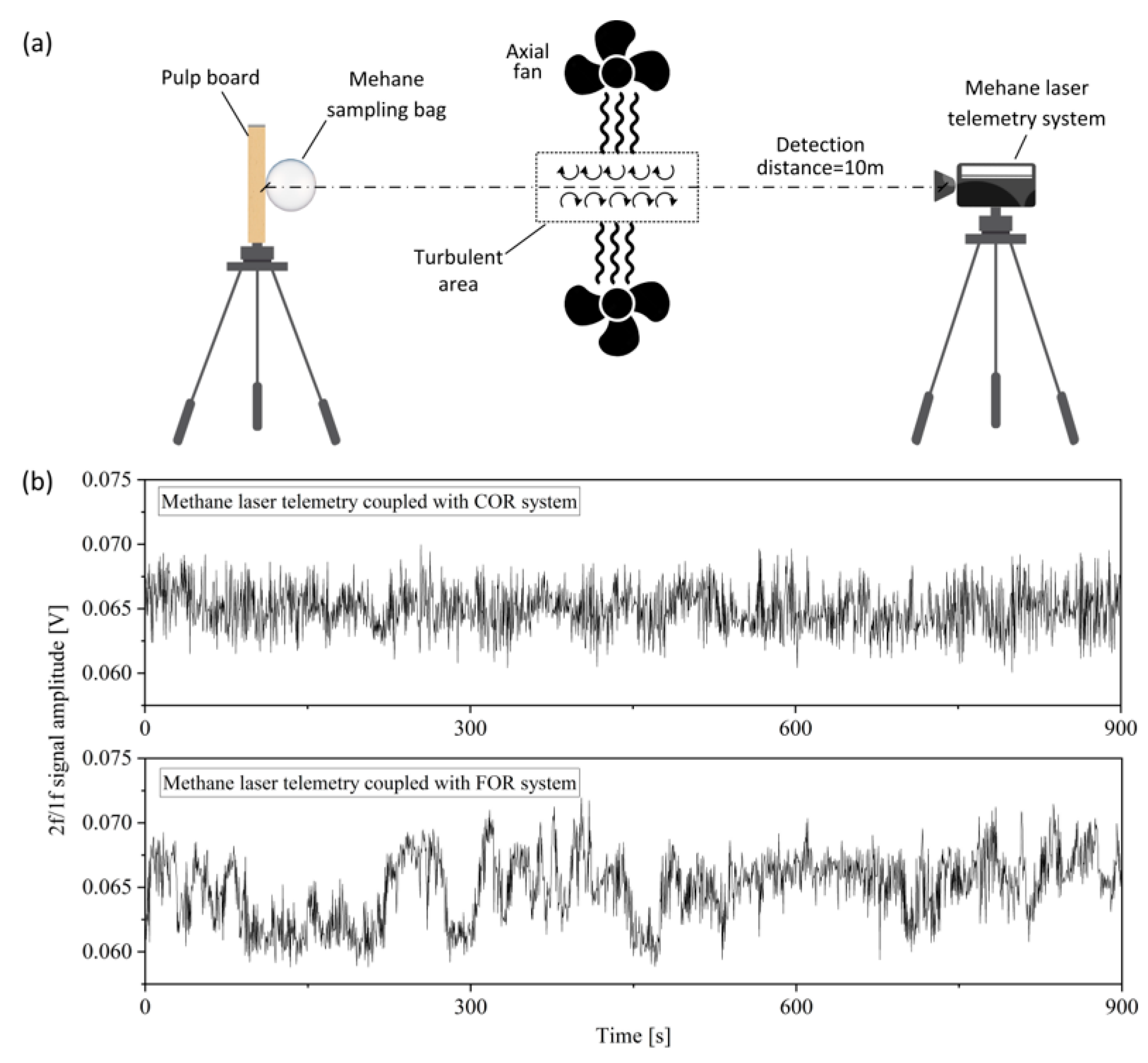
| Diameter [mm] | Focal Length [mm] | Thickness [mm] | Pitch [°] | Groove Spacing [mm] | Refractive Index |
|---|---|---|---|---|---|
| 50 | 93 | 2 | 1 | 10 | 1.516 |
| Stage Number | 1 | 2 | 3 | 4 | 5 | 6 | 7 | 8 | 9 | 10 | 11 | 12 |
|---|---|---|---|---|---|---|---|---|---|---|---|---|
| Incident aperture [mm] | 6.20 | 7.00 | 7.80 | 8.50 | 9.10 | 9.60 | 10.10 | 10.50 | 10.84 | 11.14 | 11.34 | 11.44 |
| Exit aperture [mm] | 5.00 | 6.20 | 7.00 | 7.80 | 8.50 | 9.10 | 9.60 | 10.10 | 10.50 | 10.84 | 11.14 | 11.34 |
| Length [mm] | 2.00 | 2.00 | 2.00 | 2.00 | 2.00 | 2.00 | 2.00 | 2.00 | 2.00 | 2.00 | 2.00 | 2.00 |
Disclaimer/Publisher’s Note: The statements, opinions and data contained in all publications are solely those of the individual author(s) and contributor(s) and not of MDPI and/or the editor(s). MDPI and/or the editor(s) disclaim responsibility for any injury to people or property resulting from any ideas, methods, instructions or products referred to in the content. |
© 2023 by the authors. Licensee MDPI, Basel, Switzerland. This article is an open access article distributed under the terms and conditions of the Creative Commons Attribution (CC BY) license (https://creativecommons.org/licenses/by/4.0/).
Share and Cite
Geng, D.; Wang, D.; Li, Y.; Zhou, W.; Qi, H. Detection Stability Improvement of Near-Infrared Laser Telemetry for Methane Emission from Oil/Gas Station Using a Catadioptric Optical Receiver. Energies 2023, 16, 3854. https://doi.org/10.3390/en16093854
Geng D, Wang D, Li Y, Zhou W, Qi H. Detection Stability Improvement of Near-Infrared Laser Telemetry for Methane Emission from Oil/Gas Station Using a Catadioptric Optical Receiver. Energies. 2023; 16(9):3854. https://doi.org/10.3390/en16093854
Chicago/Turabian StyleGeng, Dai, Di Wang, Yushuang Li, Wei Zhou, and Hanbing Qi. 2023. "Detection Stability Improvement of Near-Infrared Laser Telemetry for Methane Emission from Oil/Gas Station Using a Catadioptric Optical Receiver" Energies 16, no. 9: 3854. https://doi.org/10.3390/en16093854
APA StyleGeng, D., Wang, D., Li, Y., Zhou, W., & Qi, H. (2023). Detection Stability Improvement of Near-Infrared Laser Telemetry for Methane Emission from Oil/Gas Station Using a Catadioptric Optical Receiver. Energies, 16(9), 3854. https://doi.org/10.3390/en16093854






